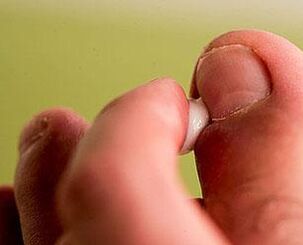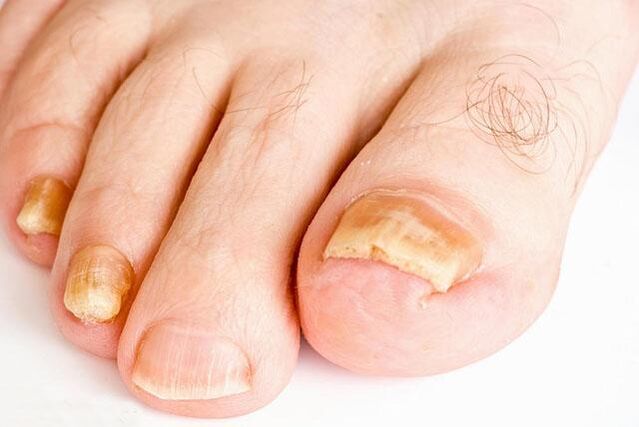
Onychomycosis is a widespread (up to 18% of the population) fungal nail disease. It affects all ages, and over the past decade, an increase in the number of those affected has also been observed among adolescents and children. Due to the high contact and frequent recurrence, the treatment of hand and foot nail fungus is a complex and lengthy process.
When does an infection occur?
- Shoes, household items (carpets in the bathroom) and body care products (dishcloths, manicure sets) for general use families;
- Swimming pools, showers in gyms and businesses, saunas and baths.
Pathogens of the disease
Effective treatment of nail fungus is only possible with a correct laboratory diagnosis of the pathogen. In almost 90% of cases, onychomycosis is caused by different types of dermatophytes. A given species affects the relevant parts of the body that are characteristic of it:
- the nails of the feet and hands and any part of the skin;
- nail plates on the legs and skin of the interdigital spaces III-IV, the arch of the foot, the upper third of the sole, the lateral surfaces of the toes.
In rare cases, the disease is caused by other types of fungi - trichophytos, epidermophytos, much less often - yeast-like. Very rarely, onychomycosis can be caused by molds affecting the nails in the area of the first toes, especially in people over 50 years of age.
Contributing factors
Favorable conditions for the introduction and development of infection:
- Damage to the nail plate and the skin around it. This is often the result of wearing tight shoes, cosmetic procedures.
- Fingers and bones of the foot or hand.
- Leg swelling with heart disease, atherosclerosis of the lower extremities, varicose veins, Raynaud's disease (spasm of the arteries of the upper extremities).
- Endocrine diseases (especially diabetes mellitus).
- Pregnancy (due to hormonal changes and decreased immunity).
- Decreased general immunity.
- Congenital disorders in the formation of the stratum corneum of the skin.
- Severe and long-term chronic diseases that reduce the body's ability to defend itself.
- Long-term treatment with corticosteroid drugs and antibiotics, systemic and other immune diseases.
The possibility of transmission of the infection in the body by blood and lymph has already been proven.
Diagnosis of onychomycosis
The diagnosis of fungal infection is based on local and general clinical manifestations and laboratory research.

Clinical manifestations
The symptoms are very varied, depending on the type and type of pathogen. Separately, the nails of the feet (80%) and hands may be affected; it is less common to defeat the nails of the lower and upper limbs simultaneously.
Depending on the nature of the change in the nail plate, we distinguish 4 forms of damage:
- Normotrophic- characterized by a yellowish color at the end of the nail plate. It becomes dull and thickens due to the epidermal corneum layer (subungual hyperkeratosis). The shape of the affected nails does not change for a long time.
- Hypertrophic, in which the nail turns yellow and thickens, the edges loosen. The cross streaks appear gradually. The nail plate will be dirty gray and dull. In some cases (usually on the first toes) it thickens, becomes long and curved like a bird’s karma or beak (onychogryphosis).
- Atrophic- the nails are dull, greyish or yellow. They change shape, collapse at the end, partially exposing the bed. The latter is covered by loose layers of the stratum corneum.
- Onycholysis- detachment of the nail plate from the bed. With this form of fungal infection, the normal color remains only in the root area. The rest of the nail will become thinner, detach from the bed, lose its shine and become yellowish or greyish-dirty.
Combined forms are often observed. The clinical manifestations listed are not specific for certain types of fungal lesions. They can also occur in diseases that are not associated with fungi.
Some common manifestations are also possible: allergic rash on the body, increased fatigue and decreased appetite. These are explained by the ability of certain types of dermatophytes to cause allergic restructuring in the body and to release mold toxins, leading to chronic poisoning of the whole body.
Laboratory diagnostics
It consists of a collection of materials (particles of layers of the epidermis, pieces of nails). The material was poured into an alkaline alkaline solution, left at a temperature of about 20 degrees for 24 hours, and then examined under a microscope. This technique allows for the differential diagnosis of fungal and non-fungal lesions. In the presence of fungi, fibers of various thicknesses and shapes, spore groups are visible under a microscope.
The material is then placed in a special medium for the pathogen to multiply, followed by type identification and determination of susceptibility to antifungal drugs.
Characteristics of treatment
The choice of methods of therapy should take into account the form, type and extent of the lesion, the rate of nail growth, the general condition of the body and the side effects of the drugs used, especially in the case of concomitant diseases. Based on these principles, the treatment of nail fungus as well as hands has a local or complex effect.
Local principles of action
Possible if:
- the infection did not affect all nails;
- the defeat of each infected nail plate is less than half the area;
- the process is located only at the end and side of the plate, without root involvement;
- there are contraindications to the use of systemic drugs.
Topical medication
It consists of the use of a cream, solution or nail polish that contains substances that soften the nail plate. Also included are medicines used to treat nail (hand) fungi that suppress the growth and development of infection:
You can pre-apply any composition to soften the sheet and remove it layer by layer, as in the first case, and then apply a wide range of antifungal agents in the form of creams or solutions twice a day. However, they should be rubbed into the surrounding skin.

Medical hardware pedicure
The medical pedicure is used as an adjunct procedure (but not as a treatment! ), Which shortens the treatment time. The point is to use a router in the form of a metal or diamond cutter. This tool greatly facilitates the painless removal of previously softened nails to your bed. The use of the hardware method is recommended if more than 60% of the surface of the nail plate is damaged, but it is not a substitute for further drug treatment with antifungal agents.
Surgery
In cases of severe forms of onychomycosis and severe deformity of the nail, it is sometimes surgically removed under general anesthesia or conductive anesthesia with the continued use of antifungal drugs. The main disadvantage of this method is the damage to the nail bed, as a result of which the newly produced plate is left behind and irregularly shaped.
Laser treatment
This method consists of heating the nail with laser radiation in a short pulse range to a temperature of 45-47 degrees, at which point the dermatophytes are killed. The procedure is most effective in the initial stage of nail damage without deformation. Depending on the severity, 1-8 sessions should be performed at 7-60 day intervals. In case of severe lesions, local and systemic treatment should be given.

Systemic drug therapy
It is indicated for multiple nail lesions, root involvement in the process, and in the absence of local exposure.
The most effective drugs for the treatment of nail fungus are pills. contains substances such as terbinafine, fluconazole and others. They are prescribed on courses for 3-4 months and remain in the body for up to 9 months after treatment is completed. The last two drugs are used much less frequently because of their toxicity to the liver.
Systemic treatment is contraindicated in renal and hepatic disease. Only 1-2 nails can be treated topically during pregnancy and lactation, but it is better to refrain from this.
























